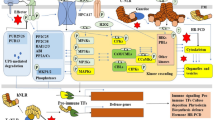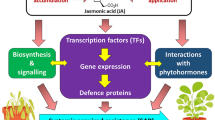Abstract
Resistance expressed by plants against different rust pathogens is a unique and a very well-coordinated process. The defense responsive genes are the performers of such responses in plants. Understanding the regulation and mechanism of action of these genes is a key constituent of strategic resistance breeding programmes. The present study is aimed at evaluating and comparing the temporal expression pattern of defense responsive genes during early infection phase in compatible and incompatible interactions between wheat and leaf rust to elucidate the molecular basis of Lr24- mediated rust resistance. Lr24 confers resistance to almost all the pathotypes of Puccinia triticina (Pt) reported from Indian subcontinent and Australia. Expression profiles of 10 pathogen responsive genes representing different classes were studied in susceptible (HS240) and resistant (HW2020) wheat near-isogenic lines interacting with Pt. The expression profiles of these genes revealed that the transcript levels of aquaporin, endochitinase, β-1,3-glucanase, Type 1 non-specific lipid transfer protein precursor, phenylalanine ammonia-lyase and caffeic acid O-methyltransferase were significantly higher in incompatible interaction. Relatively higher expression of phenylalanine ammonia-lyase and aquaporin was observed at the pre-haustorial stage [6 h post inoculation (hpi) and 12 hpi], while expression of endo-chitinase and lipid transfer protein was higher during the post-haustorial stage (24 hpi and 48 hpi) in the incompatible interaction. Induced expression of class III peroxidase was maintained throughout pre- and post-haustorial stages in the compatible interaction. The results of the current study could distinguish the defense responsive genes playing a critical role in wheat resistance or susceptibility to leaf rust. We feel that this understanding will allow devising novel strategies to regulate wheat leaf rust pathogen interactions through genetic engineering.





Similar content being viewed by others
References
Aguayo D, Pacheco N, Morales EH, Collao B, Luraschi R, Cabezas C, Calderon P et al (2015) Hydrogen peroxide and hypochlorous acid influx through the major S. typhimurium porinOmpD is affected by substitution of key residues of the channel. Arch Biochem Biophys 568:38–45
Andersen CL, Ledet-Jensen J, Orntoft T (2004) Normalization of real-time quantitative RT-PCR data: a model based variance estimation approach to identify genes suited for normalization-applied to bladder- and colon-cancer data-sets. Cancer Res 64:5245–5250
Bhardwaj SC, Prashar M, Kumar S, Gangwar OP, Gupta N, Pramod P, Khan H (2016) Patterns of physiologic diversity of Puccinia triticina on wheat in Indian subcontinent during 2008-2013. Indian J Agr Sci 86:55–64
Bhuiyan N, Selvaraj G, Wei YD, King J (2009) Gene expression profiling and silencing reveal that monolignol biosynthesis plays a critical role in penetration defence in wheat against powdery mildew invasion. J Exp Bot 60:509–521
Bienert GP, Chaumont F (2014) Aquaporin-facilitated transmembrane diffusion of hydrogen peroxide. Biochim Biophys Acta 1840:1596–1604
Campoli C, Matus-Cadiz MA, Pozniak CJ, Cattivelli L, Fowler DB (2009) Comparative expression of Cbf genes in the Triticeae under different acclimation induction temperatures. Mol Gen Genomics 282:141–152
Casassola A, Brammer SP, Chaves MS, Martinelli JA, Stefanato F, Boyd LA (2015) Changes in gene expression profiles as they relate to the adult plant leaf rust resistance in the wheat cv. Toropi. Physiol Mol Plant Pathol 89:49–54
Cho JI, Ryoo N, Ko S, Lee SK, Lee J, Jung KH, Lee YH, Bhoo SH, Winderickx J, An G et al (2006) Structure, expression, and functional analysis of the hexokinase gene family in rice (Oryza sativa). Planta 224:598–611
Ebrahim S, Usha K, Singh B (2011) Pathogenesis related (PR) proteins in plant defense mechanism. In: Mendez Vilas A (ed) Science against microbial pathogens: communicating current research and technological advances, vol 2, 3rd edn. Formatex Research Centre Publisher Badajoz, Spain, pp 1043–1054
Giberti S, Bertea CM, Narayana R, Maffei ME, Forlani G (2012) Two phenylalanine ammonia lyase isoforms are involved in the elicitor-induced response of rice to the fungal pathogen Magnaporthe oryzae. J Plant Physiol 169:249–254
Ginzinger DG (2002) Gene quantification using real-time quantitative PCR: An emerging technology hits the mainstream. Exp Hematol 30:503–512
Gulsen O, Eickhoff T, Heng-Moss T, Shearman R, Baxendale F, Sarath G, Lee D (2010) Characterization of peroxidase changes in resistant and susceptible warm-season turf grasses challenged by Blissus occiduus. Arthropod Plant Interact 4:45–55
Hano C, Martin I, Fliniaux O, Legrand B, Gutierrez L, Arroo RR et al (2006) Pinoresinol–lariciresinolreductase gene expression and secoisolariciresinol diglucoside accumulation in developing flax (Linumusitatissimum) seeds. Planta 224:1291–1301
Herrera-foessel SA, Lagudah ES, Huerta-Espino J, Hayden MJ, Bariana HS et al (2011) New slow-rusting leaf rust resistance genes Lr67 and Yr46 in wheat are pleiotropic or closely linked. Theor Appl Genet 122:239–249
Huang J, Gu M, Lai Z, Fan B, Shi K, Zhou YH, Yu JQ, Chen Z (2010) Functional analysis of the Arabidopsis PAL gene family in plant growth, development, and response to environmental stress. Plant Physiol 153:1526–1538
Jantasuriyarat C, Gowda M, Haller K et al (2005) Large scale identification of expressed sequence tags involved in rice and rice blast fungus interaction. Plant Physiol 138:105–115
Jones JD, Dangl JL (2006) The plant immune system. Nature 444:323–329
Kolmer JA, Long DL, Hughes ME (2007) Physiologic specialization of Puccinia triticina on wheat in the United States in 2005. Plant Dis 91:979–984
Kumar D, Kirti PB (2015) Pathogen-induced SGT1 of Arachisdiogoi induces cell death and enhanced disease resistance in tobacco and peanut. Plant Biotechnol J 13:73–84
Liu GS, Sheng XY, Greenshields DL et al (2005) Profiling of wheat class III peroxidase genes derived from powdery mildew-attacked epidermis reveals distinct sequence-associated expression patterns. Mol Plant-Microbe Interact 18:730–741
Liu J, Wang L, Fu Y, Li Z, Zhang Y, Zhang L, Jin L, Ye R, Ren A (2014) Association between maternal COMT gene polymorphisms and fetal neural tube defects risk in a Chinese population. Birth Defects Res Part A Clin Mol Teratol 100:22–29
Long X, Wang J, Ouellet T, Rocheleau H, Wei Y, Pu Z, Jiang Q, Lan X, Zheng Y (2010) Genome-wide identification and evaluation of novel internal control genes for Q-PCR based transcript normalization in wheat. Plant Mol Biol 74:307–311
Maher EA, Bate NJ, Ni W, Elkind Y, Dixon RA, Lamb CJ (1994) Increased disease susceptibility of transgenic tobacco plants with suppressed levels of preformed phenylpropanoid products. Proc Natl Acad Sci U S A 91:7802–7806
Manickavelu A, Kawaura K, Oishi K, Shin-I T, Kohara Y, Yahiaoui N, Keller B, Suzuki A, Yano K, Ogihara Y (2010) Comparative gene expression analysis of susceptible and resistant near-isogenic lines in common wheat infected by Puccinia triticina. DNA Res 17:211–222
McGrann GRD, Townsend BJ, Antoniw JF, Asher MJC, Mutasa-Gottgens ES (2009) Barley elicits a similar early basal defence response during host and nonhost interactions with polymyxa root parasites. Eur J Plant Pathol 123:5–15
McIntosh RA, Yamazaki Y, Dubcovsky J, Rogers J, Morris C, Somers J, Appels R, Devos KM (2013) Catalogue of gene symbols for wheat. In: KOMUGI-integrated wheat science database at http://www.shigen.nig.ac.jp/wheat/komugi/genes/download.jsp (accessed 16 January 2018)
Molina A, Segura A, Garcia-Olmedo F (1993) Lipid transfer proteins (nsLTPs) from barley and maize leaves are potent inhibitors of bacterial and fungal plant pathogens. FEBS Lett 316:119–122
Morkunas I, Ratajczak L (2014) The role of sugar signaling in plant defense responses against fungal pathogens. Acta Physiol Plant 36:1607–1619
Paolacci A, Tanzarella O, Porceddu E, Ciaffi M (2009) Identification and validation of reference genes for quantitative RT-PCR normalization in wheat. BMC Mol Biol 10(1):11
Pedreira J, Herrera MT, Zarra I, Revilla G (2011) The overexpression of AtPrx37, an apoplastic peroxidase, reduces growth in Arabidopsis. Physiol Plant 141:177–187
Pfaffl MW, Tichopad A, Prgomet C, Neuvians TP (2004) Determination of stable housekeeping genes, differentially regulated target genes and sample integrity: BestKeeper—excel-based tool using pair-wise correlations. Biotechnol Lett 26:509–515
Rieu I, Powers SJ (2009) Real-time quantitative RT-PCR: design, calculations and statistics. Plant Cell 21:1031–1033
Roelfs AP, Singh RP, Saari EE (1992) Rust diseases of wheat: concepts and methods of disease management. CIMMYT, Mexico
Romero D, Rivera ME, Cazorla FM, Codina JC, Fernández-Ortuño D, Torés JA (2008) Comparative histochemical analyses of oxidative burst and cell wall reinforcement in compatible and incompatible melon-powdery mildew (Podosphaerafusca) interactions. J Plant Physiol 165:1895–1905
Scholtz JJ, Visser B (2013) Reference gene selection for qPCR gene expression analysis of rust-infected wheat. Physiol Mol Plant Pathol 81:22–25
Serrano M, Coluccia F, Torres M, L’Haridon F, Metraux JP (2014) The cuticle and plant defense to pathogens. Front Plant Sci 5:274
Shadle GL, Wesley SV, Korth KL, Chen F, Lamb C, Dixon RA (2003) Phenylpropanoid compounds and disease resistance in transgenic tobacco with altered expression of l-phenylalanine ammonia-lyase. Phytochemistry 64:153–161
Sharma C, Saripalli G, Kumar S, Gautam T, Kumar A, Rani S, Jain N, Prasad P, Raghuvanshi S, Jain M, Sharma J, Prabhu K, Sharma P, Balyan H, Gupta P (2018) A study of transcriptome in leaf rust infected bread wheat involving seedling resistance gene Lr28. Funct Plant Biol. https://doi.org/10.1071/FP17326
Soriano JM, Royo C (2015) Dissecting the genetic architecture of leaf rust resistance in wheat by QTL meta-analysis. Phytopathology 105:1585–1593
Stakman EC, Stewart DM, Loegering WQ (1962) Identification of physiologic races of Puccinia graminis tritici. US Department of Agriculture, ARSE-617. US Gov Printing Office, Washington, p 53
Tian Y, Zhan G, Chen X, Tungruentragoon A, Lu X, Zhao J et al (2016) Virulence and simple sequence repeat marker segregation in a Puccinia striiformis f. sp. tritici population produced by selfing a Chinese isolate on Berberis shensiana. Phytopathology 106:185–191
Torres MA (2010) ROS in biotic interactions. Physiol Plant 138:414–429
Wang JR, Wang L, Gulden S, Rocheleau H, Balcerzak M, Jiro H, Cao WG, Han F, Zheng YL, George F, Ouellet T (2010) RNA profiling of Fusarium head blight-resistant wheat addition lines containing the Thinopyrum elongatum chromosome 7E. Can J Plant Pathol 32:188–214
War AR, Paulraj MG, Ahmad T, Buhroo AA, Hussain B, Ignacimuthu S et al (2012) Mechanisms of plant defense against insect herbivores. Plant Signal Behav 7:1306–1320
Way HM, Birch RG, Manners JM (2011) A comparison of individual and combined l-phenylalanine ammonia lyase and cationic peroxidase transgenes for engineering resistance in tobacco to necrotrophic pathogens. Plant Biotechnol Rep 5:301–308
Wu L, Wang S, Chen X, Wang X, Wu L, Zu X et al (2013) Proteomic and Phytohormone analysis of the response of maize (Zea mays L.) seedlings to sugarcane mosaic virus. PLoS One 8:e70295
Wu S, Wang H, Yang Z, Kong L (2014) Expression comparisons of pathogenesis-related (PR) genes in wheat in response to infection/infestation by Fusarium, yellow dwarf virus (YDV) aphid-transmitted and hessian fly. J Integr Agric 13:926–936
Acknowledgments
We sincerely thank The Director, Indian Council of Agricultural Research (ICAR)-Indian Institute of Wheat and Barley Research (IIWBR), Karnal, India for financial support. We also thank The Director, ICAR-Central Potato Research Institute (CPRI), Shimla, India for providing institutional infrastructure facilities to conduct experiments at ICAR-Central Potato Research Institute (CPRI), Shimla and to Dr. M. Sivasamy, Head, ICAR-Indian Agriculture Research Institute, Regional Station, Wellington, Tamil Nadu, India for providing the seeds of wheat NILs used in this study.
Author information
Authors and Affiliations
Corresponding author
Ethics declarations
This article does not contain any studies with human participants or animals performed by any of the authors.
Conflict of interest
The authors declare that they have no conflict of interest.
Rights and permissions
About this article
Cite this article
Prasad, P., Savadi, S., Bhardwaj, S.C. et al. Stage-specific reprogramming of defense responsive genes during Lr24-mediated leaf rust resistance in wheat. J Plant Pathol 101, 283–293 (2019). https://doi.org/10.1007/s42161-018-00199-x
Received:
Accepted:
Published:
Issue Date:
DOI: https://doi.org/10.1007/s42161-018-00199-x




